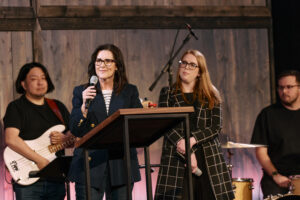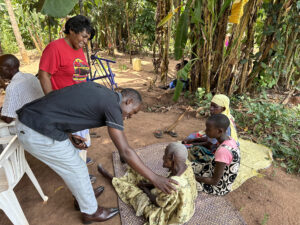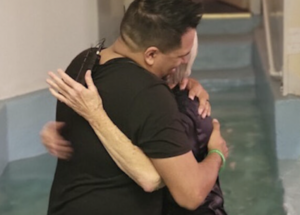
NASHVILLE, Tenn. (BP)–The state of modern-day race relations and a glimpse of the civil rights movement were discussed during a viewing of the FamilyNet Television documentary “We Shall Not Be Moved” at the Baptist Press Student Journalism Conference.
During an Oct. 11 afternoon session, students and faculty watched the Emmy-nominated documentary by FamilyNet, a broadcast division of the Southern Baptist Convention’s North American Mission Board. Michael Laney, associate professor of telecommunications and director of the communication & the arts department at Lee University in Tennessee, moderated the discussion and delivered a scholarly paper on the FamilyNet production.
“The film helps to raise the collective consciousness of a nation currently embroiled in corporate scandals, divisive partisan politics and a war on terrorism — issues in which the church seems to be mute,” Laney said. “It brings to mind a time when the African American church … staked their very lives on living out biblical truth.”
Alabama was the most segregated state in America when Rosa Parks refused to give up her seat on a Birmingham bus in 1955, Laney said. That was two weeks after Martin Luther King Jr. mailed in the dissertation that earned him a doctorate.
“He had dignity, great learning and was new in town,” Laney said. These traits opened the door for King — pastor at Dexter Avenue Baptist Church — to become the leader of a group of ministers who rallied townspeople to boycott Birmingham buses.
King actively recruited young people — some not yet teenagers — in the civil rights movement and, when criticized for putting them in harm’s way, said they were already in harm’s way because of racism, Laney said. Young people and the media, he said, were key elements in King’s plan to achieve legalized equality for all people.
King led thousands in the March on Washington that included his oft-repeated “I Have A Dream” speech.
Eighteen days later, on Sept. 15, 1963, a bomb exploded in the 16th Street Baptist Church in Birmingham. Four young women of African heritage were killed; 20 others were injured.
“Another young boy was shot that same weekend while driving his bicycle, and one black man was killed by police as hundreds of angry African Americans roamed the streets,” Laney added to the film account. “Without the presence of ABC, NBC and CBS supplying visuals for the nation to see, not many people would have been aware of the brutality that took place. The death of the four young girls was made known to everyone.”
Fred Shuttlesworth was an unsung hero in the civil rights movement, Laney said. He worked tirelessly in Selma, Ala., in the early 1960s for equal and free voting rights, and at one point “he told King if you’re not with us, we’ll do it alone,” Laney said.
“It” was a nonviolent protest march on Sunday, March 7, 1965, from Selma, over the Edmund Pettus Bridge, to the state capital in Montgomery. About 600 marchers walked steadily, quietly, until just over the apex of the bridge those in front could see — and be seen by — state troopers, some of whom were on horseback.
Newspaper and television photojournalists recorded the melee that followed. We Shall Not Be Moved included some of the brutality in a manner Laney called “sanitized” for family viewing.
“The Judgment at Nuremberg” — a stirring motion picture about the atrocities against Jewish people in Nazi Germany — aired that night on ABC television, Laney said. News footage of the carnage in Selma interrupted the movie and galvanized the nation. CBS and NBC waited until the 10 p.m. news broadcast to show their footage of the Selma event, Laney added.
“Thousands of letters and phone calls poured into the White House and the Congress, demanding that something be done,” Laney said. “King announced another march for that coming Tuesday and asked the nation’s clergy to participate.
“We Shall Not Be Moved infers that this event occurred almost spontaneously,” Laney continued. “Such a characterization fails to properly convey King’s successful use of media, his understanding of the power of televised images and his role in mastering the nuances of mediated religion.”
More than 1,500 Christian and Jewish clergy from around the world converged on Selma for that march, according to the documentary.
“Though that march itself went peacefully, four white ministers were assaulted that night as they left a restaurant,” Laney said. “The Rabbi James Reeb died from his injuries.”
Throughout the civil rights era, television media captured the sights and sounds of a people fighting for their freedom, Laney said.
“Toward the end of the film we see that it was the growing ecumenical movement and involvement of numerous churches that resulted in an avalanche of righteous indignation that could not be squelched,” Laney said. “As one of the pastors said in the film, ‘We had a spirit of freedom that the dogs could not bite out, the police could not beat out, the fire hoses could not wash out, and the jails could not lock out.'”
Racism is still a factor in America today, Laney said. The first example that came to his mind was that despite the number of people with an African heritage who live in Cleveland, Tenn., where Lee University is located, most of the people photographed in the city’s daily newspaper appear to be of European heritage.
“There needs to be an intentionality in our desire to not be racist,” Laney said. “It would be a shame to think that deep down everything is the same as it was before Dr. King. I do think his dream has been deferred; it’s been delayed.”
The moral high ground of the civil rights movement was lost when people with an African heritage responded violently to the social system that held them down, Laney said of the change in King’s nonviolent strategy that took place after King was assassinated.
“We still have institutional racism and self-segregation,” Laney said. “Sunday is still the most segregated day of the week. We’re seeing a rise in hate groups across the nation. The Ku Klux Klan is alive and well — and growing — in the United States, and we’re seeing a linkage in Europe — Germany, Austria and the United Kingdom — of neo-Nazi groups and the KKK. We can’t say racism is in our past, because it’s not.”
Students interviewed after the session agreed.
“I’ve encountered it so much,” said Gracie Meyer, a student at Blue Mountain (Miss.) College. “In the newer generations you’re not seeing nearly as much of it, but in my grandparent’s generation you still see some prejudice.
“When I’m able to state my view, I tell them blacks are just people, like you and me,” Meyer continued. “Two of my best friends in high school were black. I can’t stand to sit there and let people run them down. I guess it’s ‘do unto others.’ They’re my friends. They would take up for me.”
Lindsay Sparrow, a student at Carson-Newman College in Jefferson City, Tenn., was born in North Carolina and moved to Morristown, Tenn., when she was in the seventh grade.
“I’ve never had a class where we talked about it, but I was aware of the events mentioned in the [We Shall Not Be Moved] video,” Sparrow said. “I guess I know about it from television and the movies.
“We have moved forward so much; I don’t see racism for my generation,” Sparrow said. “I see stereotypes for black people more than I see racism,” she added. “Maybe that is a form of racism. I don’t know.”
–30–
















